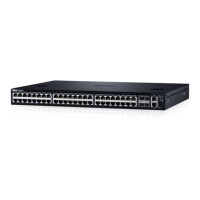For example, if the members have a link MTU of 2100 and an IP MTU 2000, the port channel’s MTU values cannot be higher than 2100 for
link MTU or 2000 bytes for IP MTU.
VLANs:
• All members of a VLAN must have the same IP MTU value.
• Members can have dierent Link MTU values. Tagged members must have a link MTU 4–bytes higher than untagged members to
account for the packet tag.
• The VLAN link MTU and IP MTU must be less than or equal to the link MTU and IP MTU values congured on the VLAN members.
For example, the VLAN contains tagged members with Link MTU of 1522 and IP MTU of 1500 and untagged members with Link MTU of
1518 and IP MTU of 1500. The VLAN’s Link MTU cannot be higher than 1518 bytes and its IP MTU cannot be higher than 1500 bytes.
Port-Pipes
A port pipe is a Dell Networking-specic term for the hardware packet-processing elements that handle network trac to and from a set of
front-end I/O ports. The physical, front-end I/O ports are referred to as a port-set. In the command-line interface, a port pipe is entered
as
port-set port-pipe-number.
Auto-Negotiation on Ethernet Interfaces
By default, auto-negotiation of speed and full duplex mode is enabled on 10/100/1000 Base-T Ethernet interfaces. Only 10GE interfaces do
not support auto-negotiation.
When using 10GE interfaces, verify that the settings on the connecting devices are set to no auto-negotiation.
The local interface and the directly connected remote interface must have the same setting, and auto-negotiation is the easiest way to
accomplish that, as long as the remote interface is capable of auto-negotiation.
NOTE
: As a best practice, Dell Networking recommends keeping auto-negotiation enabled. Only disable auto-negotiation on
switch ports that attach to devices not capable of supporting negotiation or where connectivity issues arise from interoperability
issues.
For 10/100/1000 Ethernet interfaces, the negotiation auto command is tied to the speed command. Auto-negotiation is always
enabled when the speed command is set to 1000 or auto.
NOTE
:
Setting the Speed of Ethernet Interfaces
To discover whether the remote and local interface requires manual speed synchronization, and to manually synchronize them if necessary,
use the following command sequence.
1 Determine the local interface status. Refer to the following example.
EXEC Privilege mode
show interfaces [interface | stack—unit stack-unit-number] status
2 Determine the remote interface status.
EXEC mode or EXEC Privilege mode
[Use the command on the remote system that is equivalent to the rst command.]
3 Access CONFIGURATION mode.
EXEC Privilege mode
config
350
Interfaces

